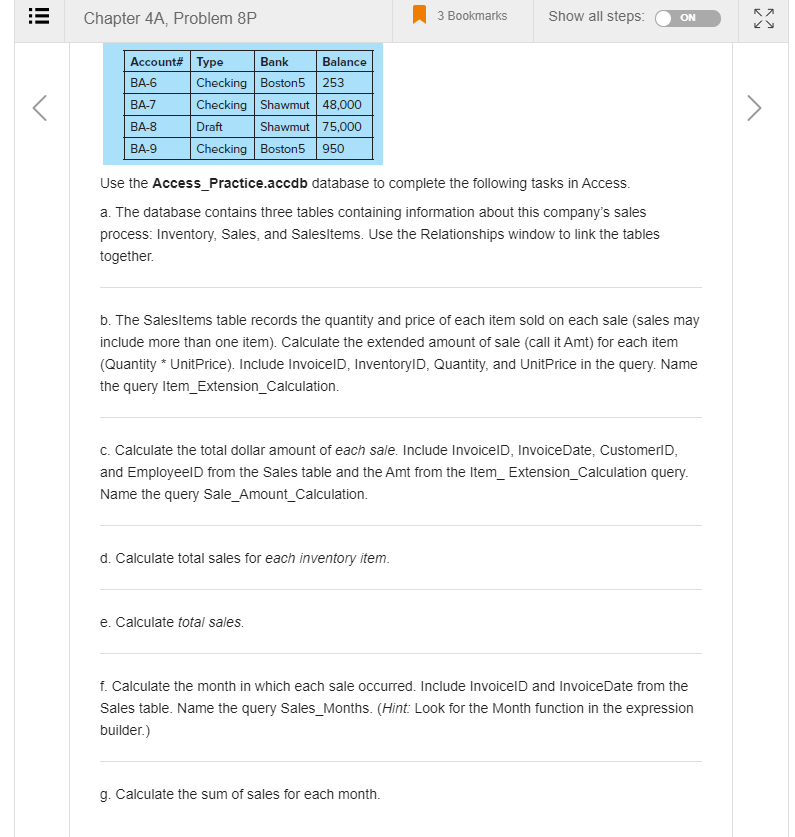
Chapter 4A, Problem 8P 3 Bookmarks Show all steps: ON Ra RA Account# Type Bank Balance BA-6 Checking Boston5 253 BA-7 Checking Shawmut 48,000 BA-8 Draft Shawmut 75,000 BA-9 Checking Boston5 950 Use the Access_Practice.accdb database to complete the following tasks in Access. a. The database contains three tables containing information about this company's sales process: Inventory, Sales, and Salesitems. Use the Relationships window to link the tables together. b. The Salesitems table records the quantity and price of each item sold on each sale (sales may include more than one item). Calculate the extended amount of sale (call it Amt) for each item (Quantity * UnitPrice). Include InvoicelD, InventoryID, Quantity, and UnitPrice in the query. Name the query Item_Extension_Calculation. C. Calculate the total dollar amount of each sale. Include InvoicelD, Invoice Date, Customerid, and Employeeld from the Sales table and the Amt from the Item_ Extension_Calculation query. Name the query Sale_Amount_Calculation. d. Calculate total sales for each inventory item. e. Calculate total sales. f. Calculate the month in which each sale occurred. Include Invoice and InvoiceDate from the Sales table. Name the query Sales_Months. (Hint: Look for the Month function in the expression builder.) g. Calculate the sum of sales for each month. Chapter 4A, Problem 8P 3 Bookmarks Show all steps: ON Ra RA Account# Type Bank Balance BA-6 Checking Boston5 253 BA-7 Checking Shawmut 48,000 BA-8 Draft Shawmut 75,000 BA-9 Checking Boston5 950 Use the Access_Practice.accdb database to complete the following tasks in Access. a. The database contains three tables containing information about this company's sales process: Inventory, Sales, and Salesitems. Use the Relationships window to link the tables together. b. The Salesitems table records the quantity and price of each item sold on each sale (sales may include more than one item). Calculate the extended amount of sale (call it Amt) for each item (Quantity * UnitPrice). Include InvoicelD, InventoryID, Quantity, and UnitPrice in the query. Name the query Item_Extension_Calculation. C. Calculate the total dollar amount of each sale. Include InvoicelD, Invoice Date, Customerid, and Employeeld from the Sales table and the Amt from the Item_ Extension_Calculation query. Name the query Sale_Amount_Calculation. d. Calculate total sales for each inventory item. e. Calculate total sales. f. Calculate the month in which each sale occurred. Include Invoice and InvoiceDate from the Sales table. Name the query Sales_Months. (Hint: Look for the Month function in the expression builder.) g. Calculate the sum of sales for each month







